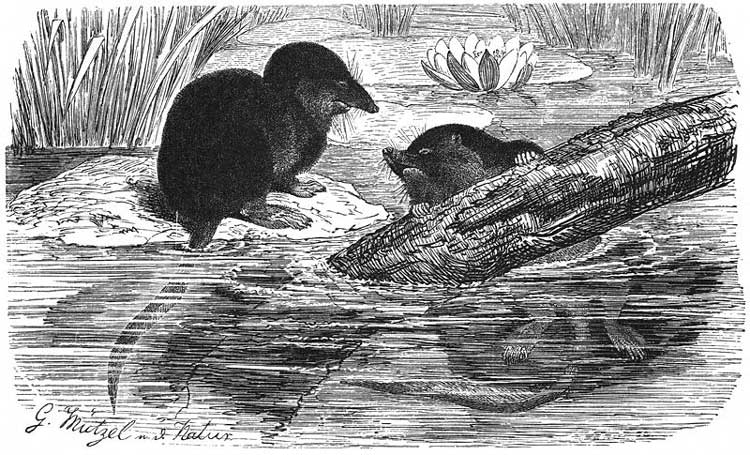Cladus: Eukaryota
Supergroup: Opisthokonta
Regnum: Animalia
Subregnum: Eumetazoa
Cladus: Bilateria
Cladus: Nephrozoa
Cladus: Deuterostomia
Phylum: Chordata
Subphylum: Vertebrata
Infraphylum: Gnathostomata
Superclassis: Tetrapoda
Classis: Mammalia
Subclassis: Theria
Infraclassis: Placentalia
Ordo: Soricomorpha
Familia: Soricidae
Subfamilia: Soricinae
Tribus: Nectogalini
Genus: Neomys
Species: Neomys fodiens
Name
Neomys fodiens (Pennant, 1771)
Type Locality: Berlin, Germany
Holotype: ZMB-62470
Synonyms
* Neomys albiventris (de Sélys Longchamps, 1839)
* Neomys albus (Bechstein, 1800)
* Neomys argenteus Ognev, 1922
* Neomys fluviatilis (Bechstein, 1793)
* Neomys griseogularis (Fitzinger, 1868)
* Neomys intermedius Brunner, 1952
* Neomys leucotis (de Sélys Longchamps, 1839)
* Neomys limchunhunii Won, 1954
* Neomys longobarda (Sordelli, 1899)
* Neomys nigricans (Nilsson, 1845)
* Neomys orientalis Hinton, 1915
* Neomys niethammeri Bühler, 1963
* Neomys stresemanni Stein, 1931
* Neomys watasei Kishida, 1930
* Neomys fodiens alpestris Burg, 1924
* Neomys fodiens bicolor (Shaw, 1791)
* Neomys fodiens brachyotus Ognev, 1922
* Neomys fodiens dagestanicus Heptner & Formozov, 1928
* Neomys fodiens naias Barrett-Hamilton, 1905
* Neomys fodiens minor Miller, 1901
* Neomys fodiens nanus Lydekker, 1906
* Neomys fodiens orientis Thomas, 1914
* Neomys fodiens watasei Kuroda, 1941
* Sorex aquaticus (Müller, 1776)
* Sorex canicularius (Bechstein, 1800)
* Sorex carinatus (Hermann, 1780)
* Sorex ciliatus (Sowerby, 1805)
* Sorex collaris (Desmarest, 1818)
* Sorex daubentonii (Erxleben, 1777)
* Sorex eremita (Meyer, 1793)
* Sorex fimbriatus (Fitzinger, 1868)
* Sorex fodiens Pennant, 1771
* Sorex hermanni (Duvernoy, 1835)
* Sorex hydrophilus (Pallas, 1811)
* Sorex intermedius (Cornalia, 1870)
* Sorex lineatus (E. Geoffroy, 1811)
* Sorex liricaudatus (Kerr, 1792)
* Sorex macrourus (Lehmann, 1822)
* Sorex musculus (Wagler, 1832)
* Sorex natans (Brehm, 1826)
* Sorex nigripes (Melchior, 1834)
* Sorex psilurus (Wagler, 1832)
* Sorex remifer (E. Geoffroy, 1811)
* Sorex rivalis (Brehm, 1830)
* Sorex stagnatilis (Brehm, 1826)
* Crosopus ignotus Fatio, 1905
* Crossopus sowerbyi (Bonaparte, 1840)
* Amphisorex linneana (Gray, 1838)
* Amphisorex pennantii (Gray, 1838)
References
* Pennant, T. 1771. Synopsis of Quadrupeds. J. Monk, Chester, 308 pp.
* Neomys fodiens on Mammal Species of the World.
Mammal Species of the World: A Taxonomic and Geographic Reference, 2 Volume Set edited by Don E. Wilson, DeeAnn M. Reeder
* IUCN link: Neomys fodiens (Pennant, 1771) (Least Concern)
* Neomys fodiens (Pennant, 1771) Report on ITIS
Vernacular names
Deutsch: Eurasische Wasserspitzmaus
Ελληνικά : Νερομυγαλίδα
English: Eurasian Water Shrew, Northern Water Shrew, Water Shrew
Español: Musgaño Patiblanco
Français: Crossope Aquatique
Polski: Rzęsorek rzeczek
-----------
The Eurasian Water Shrew, Neomys fodiens, known in the United Kingdom as the Water Shrew, is a relatively large shrew, up to 10 centimetres (4 in) long, with a tail up to three-quarters as long again. It has short dark fur, often with a few white tufts, a white belly, and a few stiff hairs around the feet and tail. It lives close to fresh water, hunting its invertebrate prey in the water and nearby. Its fur traps bubbles of air in the water which greatly aids its buoyancy, but requires it to anchor itself if it wishes to remain underwater for more than the briefest of dives.
Like many shrews the Water Shrew has venomous saliva, making it one of the few venomous mammals, although it is not able to puncture the skin of large animals such as humans. Highly territorial, it lives a solitary life and is found throughout northern Eurasia, from Ireland to North Korea.
References
1. ^ Hutterer, Rainer (November 16, 2005). Don E. Wilson and DeeAnn M. Reeder. ed. Mammal Species of the World (3rd ed.). Baltimore: Johns Hopkins University Press. pp. 279. ISBN 978-0-8018-8221-0. http://www.bucknell.edu/msw3.
2. ^ Insectivore Specialist Group (1996). Neomys fodiens. 2006. IUCN Red List of Threatened Species. IUCN 2006. www.iucnredlist.org. Retrieved on 5 May 2006.


